As expected, the median San Diego condo price is now down on a year-over-year basis. With that scary milestone we begin our Halloween episode of the Monthly Housing Report.
Prices
It still looks like the top is in for San Diego home prices:
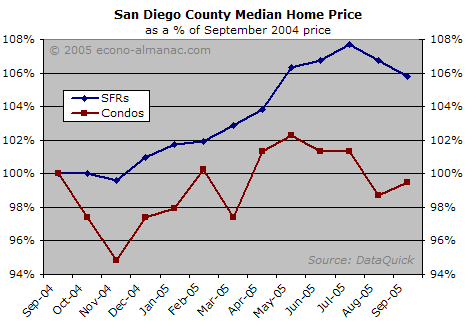
As expected, the median condo price is now down on a year-over-year basis. SFR prices, while still positive for the year, appear to have peaked back in July.
The breadth indicators actually showed a slight improvement over last month. For both condos and SFRs, more zip codes had positive year-over-year price changes than in the prior month, and fewer zip codes (or the same amount, with condos) saw price declines of 5% or more.
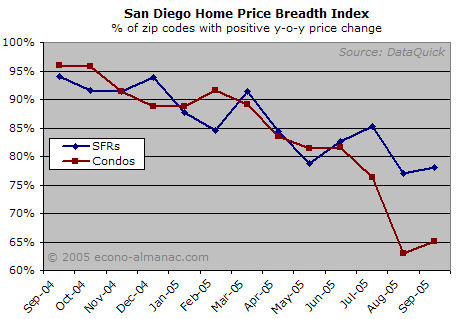
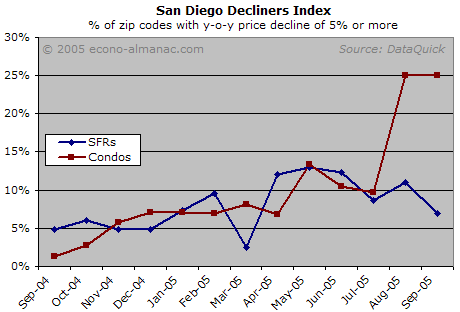
What this means is that while the overall price trend is deteriorating, different regions of San Diego are behaving more similarly to one another than they did the prior month. The slight month-to-month rise isn’t all that meaningful, though, as the trend remains the same: SFR pricing power is relatively uniform across San Diego, whereas condo pricing power has been deteriorating noticably faster in some zip codes than in others.
Sales Volume
It appears that the prior month’s jump in housing activity was a one-off:

Year-over-year sales growth (which is more interesting than raw sales numbers as it abstracts out the seasonal changes) has reverted to its pre-August pattern of flattish for SFRs and around 10% down for condos. I think that August’s spike in closed sales (which for the most part represents homes going into escrow in July) was caused by fence-sitters being scared into action by the fact that rates, after sitting tight for all of 2005, started to rise noticably:
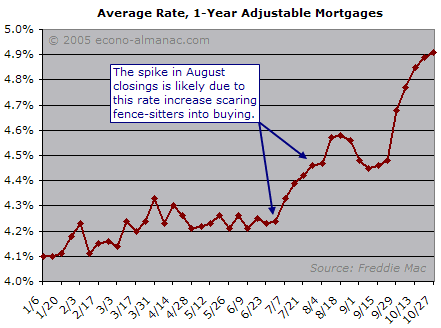
It doesn’t appear to have been a very crowded fence, however, because the spike in volume only lasted a month. My sources tell me that real estate activity has slowed even more in October. Aside from indicating a declining demand for housing, this slowdown in volume will eventually start to squeeze San Diego’s bloated real estate sector, causing a loss of jobs.
Inventory
Inventory has risen again, although the rate of growth has slowed:

There’s nothing new here, really, as inventory has been rising steadily since February. Last year, inventory leveled off between October and November and then declined somewhat as people gave up on the idea of selling their homes and decided to wait until spring. I’m sure this dynamic will re-assert itself again, as not too many homeowners are yet in the position where they are being forced to sell. On the other hand, there are a lot more people who buy into the idea of a real estate bubble than there were a year ago. Perhaps these folks will not want to chance waiting until spring. It should be interesting to see how the inventory situation plays out.
Meanwhile, inventory growth finally took a breather in Craneville, USA:
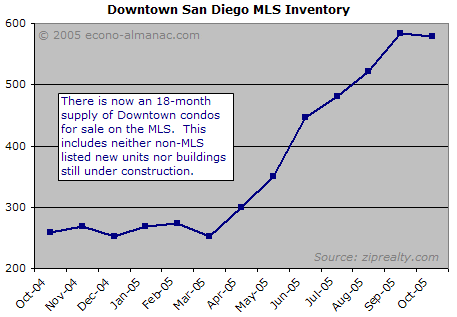
Assuming sales continue at the pace they’ve shown year-to-date, there is now an 18-month supply of Downtown condos on the MLS. This doesn’t include new units being sold directly by the builder. It also doesn’t include the units under construction that are slated to come online within that 18-month period. So the 18-month figure is likely only to go up from here.
Next time someone starts spouting off about San Diego’s alleged housing shortage, see what he or she thinks about the 1.5 year (and growing) supply of Downtown inventory just sitting there waiting to be bought.
Conclusion
As I mentioned at the outset, I see nothing to undermine the idea that San Diego housing has already seen its price peak. The confluence of rising interest rates, an increasing acceptance of the housing bubble thesis, and an enormous inventory overhang renders it unlikely that the market will strengthen.
I continue to believe that, unless mortgage rates change significantly for the better, the slow unwinding of San Diego’s multi-year housing mania has begun.
